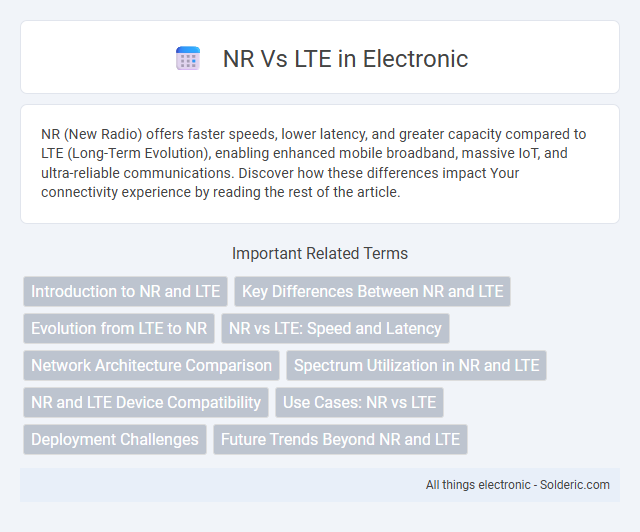NR (New Radio) offers faster speeds, lower latency, and greater capacity compared to LTE (Long-Term Evolution), enabling enhanced mobile broadband, massive IoT, and ultra-reliable communications. Discover how these differences impact Your connectivity experience by reading the rest of the article.
Comparison Table
| Aspect | NR (New Radio) | LTE (Long-Term Evolution) |
|---|---|---|
| Generation | 5G | 4G |
| Frequency Bands | Sub-6 GHz and mmWave (24 GHz and above) | Sub-6 GHz |
| Latency | 1 ms (ultra-low) | 10-30 ms |
| Peak Data Rate | Up to 20 Gbps | Up to 1 Gbps |
| Bandwidth | Up to 400 MHz | Up to 20 MHz |
| MIMO Support | Massive MIMO | MIMO |
| Deployment | Standalone (SA) and Non-Standalone (NSA) | Standalone |
| Use Cases | Enhanced mobile broadband, URLLC, mMTC | Mobile broadband |
| Network Architecture | Cloud-native, virtualized core | Dedicated EPC core |
| Modulation | Up to 256-QAM | Up to 64-QAM |
Introduction to NR and LTE
NR (New Radio) is the radio access technology introduced for 5G networks, designed to deliver ultra-low latency, enhanced mobile broadband, and massive machine-type communication. LTE (Long-Term Evolution) serves as the foundation of 4G networks, providing high-speed data access and improved spectral efficiency for mobile broadband services. NR builds upon LTE's legacy by supporting higher frequency bands, advanced MIMO configurations, and flexible numerologies to meet diverse 5G use cases.
Key Differences Between NR and LTE
NR (New Radio) supports higher bandwidths up to 400 MHz, enabling faster data rates compared to LTE's maximum of 20 MHz. NR uses flexible numerology and advanced beamforming technologies, enhancing latency and reliability beyond LTE's fixed subcarrier spacing and limited MIMO capabilities. Your network experience improves with NR's support for ultra-low latency and massive connectivity, unlike LTE which primarily targets enhanced mobile broadband services.
Evolution from LTE to NR
The evolution from LTE (Long-Term Evolution) to NR (New Radio) represents a significant leap in mobile network technology, designed to meet the high-speed, low-latency demands of 5G. NR introduces advanced features such as enhanced massive MIMO, flexible numerology, and dynamic spectrum sharing, enabling better performance and efficiency compared to LTE. Your network experience improves with NR's ability to support ultra-reliable low-latency communications (URLLC) and massive machine-type communications (mMTC), driving innovation across industries.
NR vs LTE: Speed and Latency
NR (New Radio) technology delivers significantly higher speeds and lower latency compared to LTE, supporting peak download rates up to 20 Gbps and latency as low as 1 ms. LTE maximum speeds peak around 1 Gbps with latencies typically between 30-50 ms, making NR ideal for applications requiring real-time responsiveness such as augmented reality and autonomous driving. Your experience with 5G NR will provide smoother, faster connectivity and near-instantaneous communication compared to the more established LTE networks.
Network Architecture Comparison
NR (New Radio) features a flexible, modular network architecture supporting both standalone and non-standalone deployments, enhancing scalability and efficiency compared to LTE's more rigid Evolved Packet Core (EPC) framework. LTE relies on a centralized architecture with distinct control and user plane separation, whereas NR introduces a service-based architecture (SBA) that enables dynamic network slicing and improved resource allocation. You benefit from NR's advanced architecture through lower latency, higher throughput, and better integration with 5G core networks, making it optimal for future-proof connectivity.
Spectrum Utilization in NR and LTE
NR (New Radio) offers enhanced spectrum utilization compared to LTE through flexible numerology and scalable bandwidth, supporting wider frequency ranges from sub-1 GHz to millimeter waves. LTE operates primarily in licensed bands with fixed bandwidth sizes, limiting its efficiency in adapting to varying spectrum conditions. Your network can achieve higher data rates and lower latency by leveraging NR's dynamic spectrum sharing and advanced spectral efficiency techniques.
NR and LTE Device Compatibility
NR (New Radio) and LTE (Long-Term Evolution) devices often share compatibility through dual-mode chipsets that support both technologies, enabling seamless connectivity and network transition. LTE devices operate on frequency bands and modulation schemes distinct from NR, while NR introduces advanced features such as beamforming and massive MIMO for enhanced performance. Compatibility challenges arise when older LTE-only devices cannot access 5G NR networks, highlighting the importance of multi-mode devices for future-proof communication.
Use Cases: NR vs LTE
NR (New Radio) supports advanced use cases like enhanced mobile broadband (eMBB), ultra-reliable low-latency communications (URLLC), and massive machine-type communications (mMTC), enabling applications such as augmented reality, autonomous vehicles, and smart cities. LTE primarily caters to traditional mobile broadband and voice services, with limited support for low-latency or massive IoT deployments. NR's flexibility and higher throughput make it ideal for future 5G ecosystems, while LTE continues to provide reliable coverage for existing 4G networks.
Deployment Challenges
NR (New Radio) faces deployment challenges including limited initial infrastructure compatibility and higher complexity in integrating with existing LTE networks. LTE benefits from a mature ecosystem and widespread availability but struggles with capacity and latency demands of modern applications. Your network upgrade strategy must address seamless interworking and efficient spectrum allocation to ensure smooth transition from LTE to NR.
Future Trends Beyond NR and LTE
Emerging technologies such as 6G are set to surpass the capabilities of NR and LTE by integrating AI-driven network management and holographic communications, enabling ultra-low latency and unprecedented data rates. Your connectivity experience will evolve with advancements in terahertz frequency bands and pervasive edge computing, supporting real-time immersive applications and massive IoT deployments. These future trends emphasize seamless integration of digital and physical worlds, pushing beyond current generational limits of NR and LTE.
NR vs LTE Infographic

 solderic.com
solderic.com